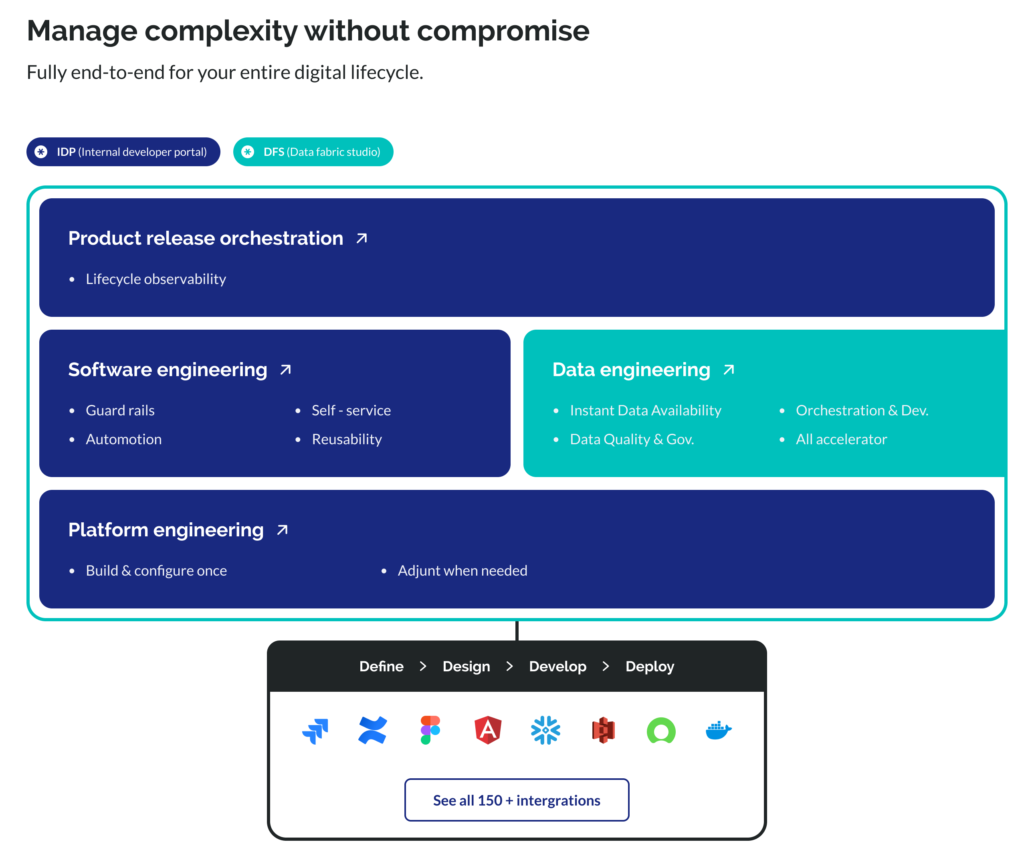

Setting up Calibo can look different for every company because each has its tech setup and different needs. This blog will help you understand how to get started with Calibo and make it work best for you.
We hope you find it helpful, and remember, if you have more questions or need a hand, don’t hesitate to reach out—we’re happy to help.
1. How can we migrate what we have on-premise now to the cloud, to third party tools?
The notion of “migration” to the cloud does not apply in most cases. Unless there is a cloud-native equivalent version of an on-premises tech stack (such as Jira, Confluence, or Kubernetes), the idea of migrating from on-premise to the cloud isn’t always relevant.
When adopting a cloud-first or cloud-native strategy, enterprises typically explore what they can actually “migrate” and what equivalent cloud-native technologies and tools they can “adopt” to retain as many of the existing capabilities they currently have through existing on-premises-only technologies and tools.
The first step in adopting a cloud-first or cloud-native strategy is to assess which cloud technologies to use.
Calibo’s platform provides cloud infrastructure as well as software and data product development and orchestration – through its integration with 150+ best-of-breed cloud technologies and tools.
As such, Calibo’s services team can work with you to perform the cloud migration/adoption assessment to establish which technologies can get you going immediately.
If you start using Calibo, you can use the out-of-the-box platform integrations to start developing software and data products almost immediately.
Learn more about our platform setup options on our offering page, and learn more about the platform in our factsheets.
2. I need an easy-to-use self-service platform I can set up quickly and use immediately. How can Calibo support?
If you want to allow easy and standardized self-service setup and deployment to speed up software releases in your business, here’s an example of what you may be experiencing:
Your pain points:
- It takes too long (days to weeks) for infrastructure teams to provision development environments.
- Too much dependency on infrastructure and operations teams to promote applications to various environments (from development, to testing, to staging, to production)
- There are several inconsistencies in how different application teams develop and deploy their products, leading to discrepancies in implementing testing and security assessment policies to assure quality deliverables.
How can Calibo solve this?
- Platform teams configure the Calibo platform to setup up the cloud accounts like AWS or Azure, environment provisioning scripts and machine sizes, development as well as deployment tech stacks and tools like GitLab, GitHub, Jenkins, Java, React, etc. and assign development team member access to those configurations.
- This enables the development team members to self-provision their tech-stack specific environments to begin their development work whenever they are ready to do so – eliminating delays associate with submitting tickets to the infrastructure operations teams and waiting on them to provision their environments.
- The software development process typically requires applications to be deployed in various environments for different purposes.
- For example, a development team will promote their application to a dedicated test environment to facilitate QA test activities. Once completed, the application may be promoted to the UAT environment or directly to a Staging environment for production-level testing and simulations prior to finalizing decisions to promote the application to production.
- Software product teams typically depend on IT operations teams to create the environments and promote the applications to the various environments – leading to long wait times.
- When using Calibo, development teams are able to perform those activities by themselves, thus expediting the process and freeing the IT operations teams to focus on other high-priority tasks.
- Platform teams promote standardization and guardrails across multiple development teams by configuring template-based policies related to tech stacks, source code repos, CI/CD pipeline development, and deployment environments.

3. How can we accelerate digital delivery with our existing end-to-end data and analytics tool stack?
If you have an existing data and analytics tool stack, and want to speed up digital product delivery, Calibo can still help. You may be experiencing the following challenges.
Your pain points:
- You have many different tools that need to be managed.
- You may want to focus on automating and accelerating and not reduce or replace your existing tools.
- Infrastructure/environment provisioning: for every new project it takes you at least 3-4 weeks until your teams can start work.
- Automated testing means a lot of time lost, and you’d like to accelerate this process.
- You have limited overall visibility of how different projects progress and where any blockages are.
How can Calibo solve this?
- Calibo is an orchestration platform that integrates multiple tools and technologies within the customer’s technology ecosystem. Platform teams will configure connections from the Calibo platform to your existing tools and tech stack account instances within the customer’s technology ecosystem.
- They will then grant access to your data product team members to use those tech stack configuration instances in Calibo to develop data pipelines and perform any related software engineering activities, such as the development and deployment of machine learning algorithms with Jupyter Notebook.
- By pre-configuring the tech stacks on the Calibo platform and granting developers access to those configured tech stacks, platform teams can provide self-service infrastructure/environment provisioning capabilities to the product teams – thereby eliminating wait times associated with dependencies on IT operations teams to provision environments.
- The CI/CD pipeline templates support capabilities for adding various forms of automated tests (unit, functional and security assessment) as individual steps within the pipeline. The specific test scope covered by the scripts are left to the development teams to define (based on the application use cases and user stories) but the scripts are executed each time the CI/CD pipeline runs.
- The Calibo platform encourages adherence to the standard software development lifecycle – define, design, develop, deploy and monitor – and supports integration with Jira for requirement management and agile planning and monitoring of development sprints.
- As product teams execute their development sprints and apply status updates to the sprint-related tasks and user stories, the Calibo platform continuously collects and presents the data via Agile metrics dashboards for all interested stakeholders to gain centralized access. This gives everyone involved a clear view of project progress in one place.
The Calibo platform can make your software development smoother, give your teams more control, and speed up your digital projects.
By connecting with your existing tools and offering a clear view of what’s happening, Calibo helps make everything run more efficiently. If you’re looking to optimize your processes and embrace the cloud, consider how Calibo can support your goals. We’re eager to help you get there and are always here to answer any questions.
Contact us here or book a meeting if you have specific questions.
Trending articles

Overcoming the overwhelm: How Enterprise Architects can get more support for technology led innovation
Enterprise Architects (EAs), this one is for you! If the constant pressure to align tech strategies with business goals has you feeling cornered, you’re not alone. Today, you need to juggle numerous challenges—from siloed operations stalling projects to the rapid emergence of AI altering traditional frameworks. Yet, with the right strategies, EAs can transform…

Why combine an Internal Developer Portal and a Data Fabric Studio?
Are you asking this exact question? You’re not alone! Many IT leaders are on a quest to improve efficiency and spark innovation in their software development and data engineering processes. You may wonder why it’s a good idea to combine an Internal Developer Portal and a Data Fabric Studio – what’s the benefit? What IT…

Data mesh vs data fabric: Understanding key differences and benefits
One thing I love about working in tech is that the landscape is constantly changing. Like the weeping angels in Dr Who – every time you turn back and look – the tech landscape has moved slightly. Unlike the weeping angels, however – this progress is for the betterment of all. (And slightly less murderous).…

Best practices for developing AI solutions with a self-service platform
Enterprises are feeling increasing pressure to integrate Artificial Intelligence (AI) into their operations. This urgency is pushing leadership teams to adjust their investment strategies to keep up. Recent advancements in Generative AI (GenAI) are further increasing this pressure, as these technologies promise to enhance productivity and efficiency across the organization. For example, Gartner™ expects GenAI…

More from Calibo
One platform, whether you’re in data or digital.
Find out more about our end-to-end enterprise solution.